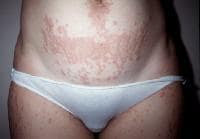Pruritic Urticarial Papules and Plaques of Pregnancy
Background
Pruritic urticarial papules and plaques of pregnancy (PUPPP) is a benign dermatosis that usually arises late in the third trimester of a first pregnancy.1 The entity previously had been reported as toxemic rash of pregnancy,2 toxemic erythema of pregnancy, and late-onset prurigo of pregnancy. The term polymorphic eruption of pregnancy (PEP) is used extensively in Great Britain, while PUPPP typically is used in the United States. Following atopic eruption of pregnancy, which occurs earlier in gestation, PUPPP is the second most common dermatoses of pregnancy.3
Frequency
International
Pruritic urticarial papules and plaques of pregnancy (PUPPP) occur in 1 out of 160-240 initial pregnancies.
Mortality/Morbidity
No mortality is associated with pruritic urticarial papules and plaques of pregnancy (PUPPP). The mere appearance of an unusual skin eruption in pregnancy can provoke anxiety, but the pruritus is the most distressing feature. The latter weeks of pregnancy can be associated with many physical symptoms, and the severe itching of PUPPP may further debilitate and aggravate sleep loss in the weeks prior to delivery. No known systemic complications exist for affected females, and fetal mortality or morbidity do not increase.
Race
Pruritic urticarial papules and plaques of pregnancy (PUPPP) may be less common in blacks.
Sex
Pruritic urticarial papules and plaques of pregnancy (PUPPP) occur in females only.
Age
Pruritic urticarial papules and plaques of pregnancy (PUPPP) occur during childbearing years because it is a dermatosis related to pregnancy.
Clinical
History
Pruritic urticarial papules and plaques of pregnancy (PUPPP) typically begin with intensely pruritic papules arising within striae distensae late in the third trimester of a first pregnancy. Of all cases, 73% are seen in primigravidae pregnancies.3 Additionally, 11.7 % of affected females are multiple-gestation pregnancies.4 As many as 15% of PUPPP cases arise in the immediate postpartum period.3 In a few days, the eruption spreads to the trunk and extremities. Patients present for a diagnosis of their unusual skin eruption and seek relief from the intense itching.
Physical
Classic pruritic urticarial papules and plaques of pregnancy (PUPPP) reveals papules within prominent striae distensae, as shown in the images below.
Erythematous urticarial papules and plaques of the trunk and extremities also are observed, although the periumbilical area is spared. Small vesicles often are noted, but larger bullae, though documented in one case, typically do not occur and would suggest the possibility of herpes gestationis.5 Less commonly, target lesions and annular and polycyclic wheals may be present. PUPPP usually does not affect the face, palms, or soles. Although the eruption is intensely pruritic, excoriations rarely are found. One report describes a case of PUPPP that progressed to involve the neck, arms, and legs in a photosensitive distribution as the initial abdominal involvement settled.6
Causes
The cause and pathogenesis of PUPPP are not known. A meta-analysis reveals 11.7% of patients with pruritic urticarial papules and plaques of pregnancy (PUPPP) are multiple gestation pregnancies.4 Within that group, a higher PUPPP risk for triplet (14%) over twin (2.9%) pregnancies has been published,7 suggesting a relationship between skin distension and the development of PUPPP. Most studies reveal increased maternal weight gain in patients with PUPPP when compared with normal pregnancies, further supporting the role of increased skin distension.8
A study from Israel also found maternal hypertension and induction of labor to be significantly associated with the condition.9 One large series10 of cases revealed a male-to-female infant ratio of 2:1. Investigators have identified fetal DNA in the skin of mothers with PUPPP, suggesting that chimerism might be relevant in the pathogenesis of this disorder.11 Finally, a case-control study from France confirmed previously documented associations with multiple gestations, cesarean deliveries, and male fetuses, although no relationship to maternal or fetal weight gain was noted.12
A study from Israel also found maternal hypertension and induction of labor to be significantly associated with the condition.9 One large series10 of cases revealed a male-to-female infant ratio of 2:1. Investigators have identified fetal DNA in the skin of mothers with PUPPP, suggesting that chimerism might be relevant in the pathogenesis of this disorder.11 Finally, a case-control study from France confirmed previously documented associations with multiple gestations, cesarean deliveries, and male fetuses, although no relationship to maternal or fetal weight gain was noted.12













No comments:
Post a Comment